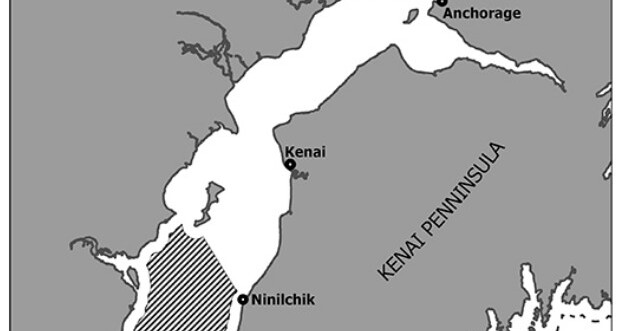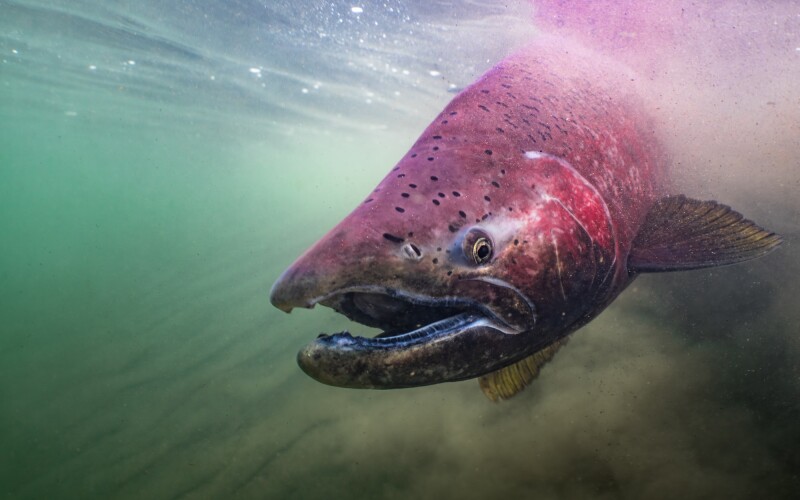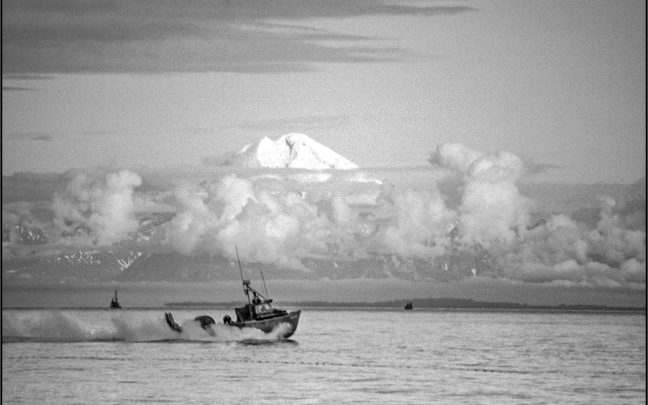As Cook Inlet drift gillnetters finished their first sockeye salmon season under the joint state-federal management regime, the harvest came in at about half of what they had hoped it would be. The fish were there, they say, but scant openings in federal waters prevented their rightful share of the harvest.
The cumulative Inlet catch as of July 31 shot past the 1.7 million mark, which was ahead of the 10-year average but lagging behind the 20-year average of 3.1 million. With some fish expected to return in early August, the final harvest could hit 2 million.
Of that total, 1,319,965 sockeyes were caught in state-managed waters within three miles of the shoreline, but only 310,340 fish came from the federally-managed U.S. Exclusive Economic Zone (EEZ), which encapsulates the majority of Cook Inlet waters beyond three miles from shore.
In the advent of the season, the industry braced for complications within the entwined management systems. For the first time in the history of the fishery, drift netters needed to procure a federal permit in addition to their state-issued, limited entry permits, and comply with federal mandates, but the bigger concern was that limited openings in federal waters would leave too many uncaught salmon.
Unlike state-managed salmon fisheries, which allow in-season adjustments to fishing time based upon escapement into the natal rivers, the federal management protocol sets a quota or a total allowable catch (TAC) based upon data from historical harvests, population surveys and other studies when funding and logistics permit. This year’s TAC for the Inlet’s federal waters had been set at 492,100 sockeyes, 25,000 cohos, 99,400 chums, 121,700 pinks and 240 chinooks, according to the final rule in the Federal Register.
Already in the comment period before publishing the final rule, a point of consternation among fishermen had been that 65 percent of the historical sockeye harvest comes from the EEZ and that the TAC should have approximated at least 1.7 million. The National Marine Fisheries Service (NMFS) disagreed with that assertion, based upon a different set of data using 47 percent of the historical catch, hence the TAC of less than a half million.
Like most fishing-related controversies, the setting of the Cook Inlet TAC lies in the interpretations of the underlying numbers. Even more unsettling to fishermen than the low TAC, fishing periods in the EEZ for 2024 had been set at two days per week, Mondays and Thursdays between June 20th and July 15, then reduced to one day per week from July 16 to July 31. The federal openings resumed a two-day schedule after August 1, with the season ending on August 15. But the fishery could be closed anytime the TAC has been caught.
Fishermen worry that in years of strong sockeye returns, like this one, the rigid openings imposed by NMFS mimic the plan previously managed by the state, which they believe compromises potential harvests and allows over-escapement into the rivers.
Huebsch and other fishermen contend that the TAC has been set artificially low in the guise of allocating fish to other user groups, such as the guided sport fishing industry, and violates at least three of the national standards as prescribed within the Magnuson-Stevens Fishery Management and Conservation Act.
By UCIDA’s calculations, last year's 2023 harvest came in at 1.6 million sockeyes, while over-escapement into the Kasilof and Kenai Rivers hit 1.65 million. On May 13, UCIDA filed a formal complaint to NMFS to re-evaluate how it sets the TAC, based upon optimum escapement into the rivers and optimum yield in the commercial fishery. The number drifters have in mind crunches out to 3 million.
Meanwhile, this year’s escapement into the Kenai and Kasilof Rivers provided the impetus to increased fishing time in the nearshore waters under state management.
“We’ve been fishing a lot in state waters,” says Lucas Stumpf, assistant area management biologist with the Alaska Department of Fish and Game (ADF&G), in Soldotna. “We can allow additional fishing time because escapement goals have been met.”

Federal management of the EEZ stems back to a 2011 court case filed by UCIDA and a party of other commercial fishermen, which challenged the methodology by which NMFS and the North Pacific Fishery Management Council (NPFMC) originally conveyed management of Cook Inlet’s EEZ to the state. The main argument is that the feds handed management off to the state without including it as part of a federal fisheries management plan - and that the state has mismanaged the fishery ever since.
Following the initial suit, NMFS and NPFMC responded to district court and Ninth Circuit Court decisions in various ways. According to NMFS, the NPFMC failed to act in implementing a viable fishery management plan (FMP) and left NMFS to institute a series of amendments, mainly Amendments 12, 14 and 16, in an attempt to manage waters of the EEZ in compliance with the Magnuson-Stevens Act and its national standards.
From the Federal Register: “Because the Council failed to take action to recommend an FMP necessary for the conservation and management of the Cook Inlet EEZ salmon fishery, NMFS developed amendment 16 to the Salmon FMP and this final rule pursuant to section 304(c) of the Magnuson-Stevens Act in order to comply with rulings from the U.S. Court of Appeals for the Ninth Circuit and the U.S. District Court for the District of Alaska, and to ensure the Salmon FMP is consistent with the Magnuson-Stevens Act.”
If you ask Huebsch and other fishermen, they’ve still got it all wrong.
“The feds have basically built their plan upon the past 20 years of bad management by the state,” says Huebsch. “So the result is another bad management plan.”
At the same time, the State of Alaska has vowed to manage the fishery in accordance with its own constitution – on the water and in the courtroom.
“We did not start this fight,” says ADF&G Commissioner Douglas Vincent-Lang. “But at the same time, we were not going to be told that we had to manage under a system that wasn’t compliant with state law and regulations.”
In the ensuing fish fracas, there are other factors at play. Though sockeyes comprise the majority of salmon swimming through the waters of the EEZ and returning to the inlet’s Kasilof and Kenai Rivers, other species in the population, such as cohos and chinooks, haven’t fared so well. Chinooks in particular have warranted protective measures, including the commercial shutdown of east side set netters for the past two years.
In essence, management practices to protect weak stocks (such as chinooks longer than 34 inches) in commingling populations have caused the demise of an entire sector of the industry. In the years between 2016 and 2022, the majority of Cook Inlet’s 440 set net permit holders churned out revenues ranging from around $3 million to almost $12 million, according to data from Alaska’s Commercial Fishery Entry Commission.
Weak runs of cohos have also translated to limited fishing time in the EEZ.
“They have precautionary TAC’s that consider a wide range of species,” says Vincent-Lang. “They still have to protect weak stocks of coho salmon through the TAC.”

Additional action that could curb – or even shut down – fishing time for the drift fleet is looming. The Wild Fish Conservancy (WFC), a Washington state-based group, is seeking to have chinooks returning to Cook Inlet listed as endangered under the Endangered Species Act. In recent years WFC has called for the shutdown of commercial trolling in Southeast to provide more chinooks as forage fish for an endangered pod of killer whales in Puget Sound.
Though the effort to protect chinooks began as an allocation fight in the courts several years ago, WFC recently petitioned NMFS for the ESA listing, and NMFS found merit in the group’s proposal. The listing, if it comes to pass, would involve nearly every chinook-rearing drainage spanning the Gulf of Alaska.
As the season languished into August, and most fishermen put up their boats and nets, Huebsch and attorneys representing UCIDA prepared for another round in the courts. Besides sending in the formal complaint about the low TAC to NMFS on May 13, UCIDA filed a brief to the court on May 29. NMFS filed a rebuttal brief on July 22.
“They’re repeating the same stuff the courts already told them they couldn’t do,” says Huebsch, of the federal management regime. “So, we’re back in court.”







